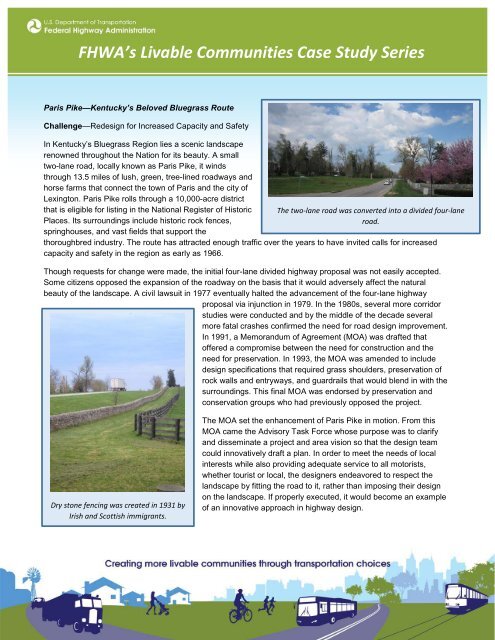Paris Pike-Kentucky's Beloved Bluegrass Route - Federal Highway ...
Paris Pike-Kentucky's Beloved Bluegrass Route - Federal Highway ...
Paris Pike-Kentucky's Beloved Bluegrass Route - Federal Highway ...
You also want an ePaper? Increase the reach of your titles
YUMPU automatically turns print PDFs into web optimized ePapers that Google loves.
FHWA’s Livable Communities Case Study Series<br />
<strong>Paris</strong> <strong>Pike</strong>—Kentucky’s <strong>Beloved</strong> <strong>Bluegrass</strong> <strong>Route</strong><br />
Challenge—Redesign for Increased Capacity and Safety<br />
In Kentucky’s <strong>Bluegrass</strong> Region lies a scenic landscape<br />
renowned throughout the Nation for its beauty. A small<br />
two-lane road, locally known as <strong>Paris</strong> <strong>Pike</strong>, it winds<br />
through 13.5 miles of lush, green, tree-lined roadways and<br />
horse farms that connect the town of <strong>Paris</strong> and the city of<br />
Lexington. <strong>Paris</strong> <strong>Pike</strong> rolls through a 10,000-acre district<br />
that is eligible for listing in the National Register of Historic<br />
Places. Its surroundings include historic rock fences,<br />
springhouses, and vast fields that support the<br />
The two-lane road was converted into a divided four-lane<br />
road.<br />
thoroughbred industry. The route has attracted enough traffic over the years to have invited calls for increased<br />
capacity and safety in the region as early as 1966.<br />
Though requests for change were made, the initial four-lane divided highway proposal was not easily accepted.<br />
Some citizens opposed the expansion of the roadway on the basis that it would adversely affect the natural<br />
beauty of the landscape. A civil lawsuit in 1977 eventually halted the advancement of the four-lane highway<br />
proposal via injunction in 1979. In the 1980s, several more corridor<br />
studies were conducted and by the middle of the decade several<br />
more fatal crashes confirmed the need for road design improvement.<br />
In 1991, a Memorandum of Agreement (MOA) was drafted that<br />
offered a compromise between the need for construction and the<br />
need for preservation. In 1993, the MOA was amended to include<br />
design specifications that required grass shoulders, preservation of<br />
rock walls and entryways, and guardrails that would blend in with the<br />
surroundings. This final MOA was endorsed by preservation and<br />
conservation groups who had previously opposed the project.<br />
Dry stone fencing was created in 1931 by<br />
Irish and Scottish immigrants.<br />
The MOA set the enhancement of <strong>Paris</strong> <strong>Pike</strong> in motion. From this<br />
MOA came the Advisory Task Force whose purpose was to clarify<br />
and disseminate a project and area vision so that the design team<br />
could innovatively draft a plan. In order to meet the needs of local<br />
interests while also providing adequate service to all motorists,<br />
whether tourist or local, the designers endeavored to respect the<br />
landscape by fitting the road to it, rather than imposing their design<br />
on the landscape. If properly executed, it would become an example<br />
of an innovative approach in highway design.
Solution—Letting the Land Lead Design<br />
Under the premise that the landscape provided a blueprint for gateways<br />
to cultural, historic, scenic, natural, archaeological, and recreational<br />
amenities, the design followed the landscape’s lead. Though the overall<br />
project cost more than others of similar capacity and purpose due to the<br />
imperative to protect the corridor’s historic nature, opportunities to save<br />
money were seized. By opting to not to destroy the rolling hills and<br />
curve around them instead, earthwork costs were considerably<br />
reduced. Avoiding the costs of cut and fill engendered a design that<br />
offered rounded side slopes for smooth, scenic, and safe navigation of<br />
the roadway.<br />
Rusted guardrails were used to blend in<br />
with the countryside.<br />
Keeping the community and various stakeholders involved throughout<br />
the process was crucial in establishing a mutually acceptable result.<br />
Public participation was encouraged through citizen task force meetings, property owner workshops, and monthly<br />
newsletters. In addition, designers provided key visualization tools such as three-dimensional models of roadway<br />
designs and interactive techniques, such as electronic polling for community input on design issues.<br />
Funding—Establishing Effective and Sustainable<br />
Work<br />
A variety of historic fences line the road.<br />
The total project cost of $108 million was<br />
77 percent federally funded through the National<br />
<strong>Highway</strong> System program. Kentucky’s dedicated<br />
road fund provided the match. An additional<br />
$60,000 came from Transportation Enhancement<br />
(TE) funds. TE funds provided training for<br />
stonemasons performing the rock fence relocation<br />
portion of the project. Thus, in addition to the<br />
overall success of the project, there are now<br />
several more stonewall masons certified as well as<br />
specifications developed during the project that can<br />
be applied by transportation departments<br />
throughout the Nation.<br />
Results—Positive End to Decades-Old Attempts<br />
In 2003, when the <strong>Pike</strong> was completed, it was projected that traffic volume would triple by 2020. Such a prospect<br />
inspired the development of a roadway design that could accommodate that increase without sacrificing the<br />
beautiful views of the countryside. Community involvement throughout the design and construction process<br />
helped to ease decades-old tensions that had impeded the progress of a necessary new vision. The <strong>Paris</strong> <strong>Pike</strong><br />
project won a 2002 Merit-Design award from the American Society of Landscape Architects, the <strong>Federal</strong> <strong>Highway</strong><br />
Administration’s Environmental Excellence Award, and the 2003 National Partnership for <strong>Highway</strong> Quality State<br />
Award.
















